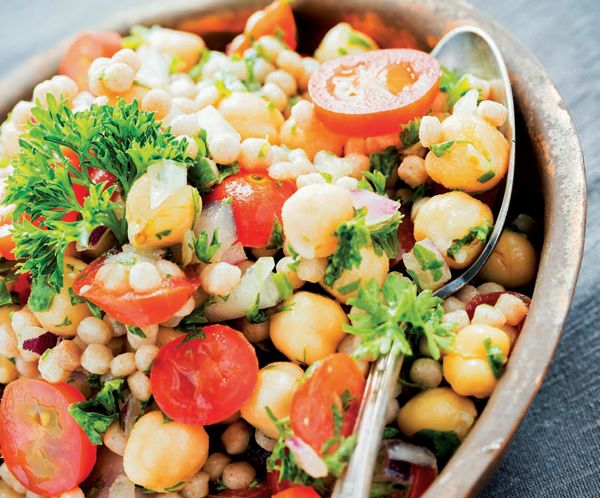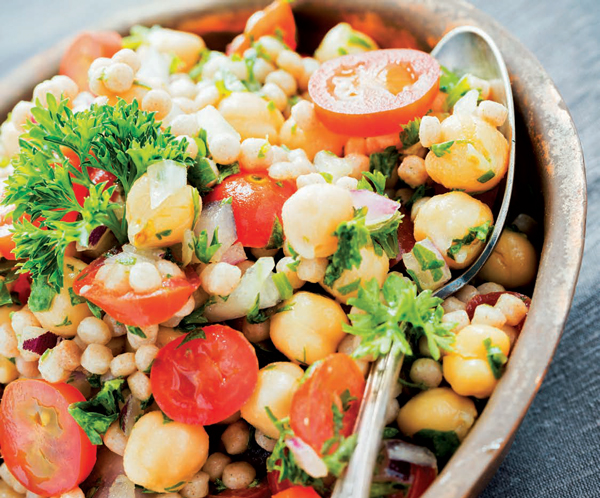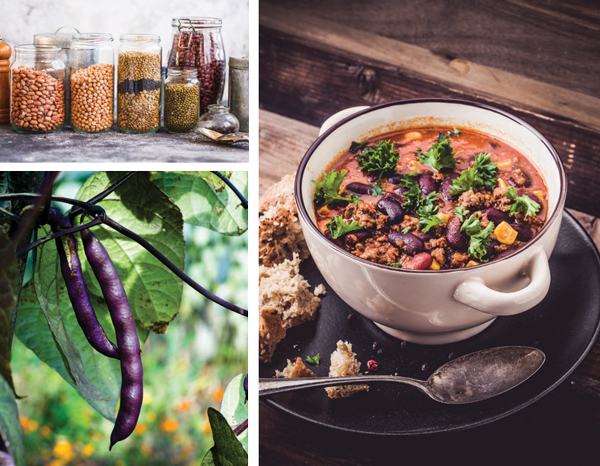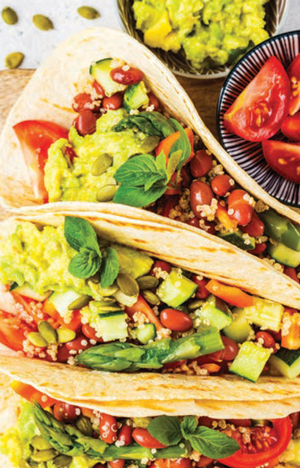The Beauty of Beans

Inexpensive to buy, easy to store, simple to cook, and versatile to use: Beans have it all. If you haven’t been stockpiling an assortment of these plant-based powerhouses, it’s time to start. Beans are members of the legume family, characterized by plants that produce a pod with seeds inside. Some of these common edible seeds include black beans, kidney beans and pinto beans, as well as their close cousins, lentils and chickpeas.
Benefits
Beans and other legumes are staples of diets all over the world, and the anchor of many a plantbased menu. They offer protein, carbohydrates and fiber in one compact package. In fact, beans feature both soluble fiber and what’s known as “resistant starch,” both of which are key for gut health because they pass undigested until they reach your colon, providing food to feed your “good” gut bacteria. Beans are rich in folate, iron, magnesium and potassium, with additional nutrients like B vitamins, phosphorus, zinc, copper and manganese.
There is also significant evidence that beans have a measurable impact on preventing cancer. The American Institute for Cancer Research published an extensive analysis based on thousands and thousands of studies, reaching a key conclusion: Eat legumes with every meal. Not just once a week or even once a day, but at every meal.
Choosing to eat more legumes also helps the planet. These crops decrease greenhouse gases, promote soil health and require less water than other crops.
Buying and cooking beans
If your primary concern is speed and convenience, stock up on canned beans. They are inexpensive, shelf-stable and allow you to throw a meal together in no time.
If you prefer to have more variety on hand and are able to plan ahead for meals, you may want to consider stocking up on dried beans, which are also shelf-stable but even less expensive than canned. They also take up less space in your pantry, and you can seek out unusual varieties like heirloom beans that you can’t get canned. If you buy beans dry, you will need to plan ahead for your meals, but prepping them is easy and not labor intensive. Starting with dried beans also allows you to control the texture, so you can leave them firmer for salads or making falafel, or cook them longer, so they are softer for making dips or refried beans.
You need to take some time to prep dried beans before you cook them. Beans are seeds that contain natural enzyme inhibitors and toxins that allow them to stay dormant for long periods of time; think about how long seeds stay in their seed packets before you plant them in your garden. Some of these enzyme inhibitors and toxins, like phytates, are what cause some folks to have gas after eating beans. To get rid of these, just soak your beans in fresh water for between 12 to 24 hours, with an added 1 to 2 tablespoons of vinegar. The acid in the vinegar helps mimic the germination process, tricking the seed into thinking it’s ready to sprout, which neutralizes phytates and makes nutrients more available during digestion. Remember that beans will swell to two to three times their dry size, so be sure to add an appropriate amount of water when soaking.
After a long soak, beans are ready to cook. They can be cooked in a variety of ways. Boil them in water in a pot on the stove, or cook them in an electric pressure cooker or even in a slow cooker. Different beans and other legumes will cook at different rates, so follow the instructions on each packet of beans (or your appliance’s cooking guide) to determine cook time.
Try a Meatless Mariachi Monday with these delicious vegan tacos using chickpeas as the main protein.
- 1 15-ounce can of chickpeas or 1 1/2 cups cooked chickpeas (prepared according to package directions)
- 1 tablespoon olive oil
- 2 tablespoons soy sauce
- 1 teaspoon chipotle chili powder
- 1 teaspoon garlic powder
Heat olive oil in a frying pan and add chickpeas. Sauté until golden. Add soy sauce, chipotle chili powder and garlic powder. Sauté for a few more minutes until chickpeas are seasoned and toasted through.
You can create a taco bar with flour and corn tortillas, fresh roasted corn kernels or canned corn, avocado slices or guacamole, salsa, cheese and fresh cilantro.
Top Beans
You can find many mainstays in the canned and dried foods aisle, including black beans, pinto beans, red kidney beans and black-eyed peas. But here are some legumes that you might want to try, to expand your bean library.
Mayocoba Beans: These go by several other names including Peruvian, canary and Mexican yellow beans. They are thin-skinned and take on a lot of the flavor of whatever dish they are in. They are mild, creamy and buttery and make a great substitute for pintos in refried beans. These are usually found bagged as dried beans, but Goya and some other brands are available canned.
Cannellini Beans: Also called white kidney beans, these Italian superstars are larger and more meaty than other white beans (such as Great Northern or Navy beans) and, because they tend to hold their shape and texture after cooking, they are great for salads and soups, including traditional Italian soups like minestrone. They boast an earthy, almost nutty flavor and make great bean dip when pureed with roasted garlic. These are readily available both dried and canned.
Black Soybeans: Most people know yellow soybeans, either in their processed form as tofu or tempeh, or as edamame. But there is another type of soybean— black soybeans—which are extremely low carb (and therefore a mainstay in vegan keto diets) and can sub in where you might use regular black beans. They have a mild flavor, making them a great choice for salads, casseroles and salsas. They are also a great choice for homemade veggie burgers. These are somewhat specialized, so you may need to order online or shop at specialty gourmet stores to find them canned or dry. If buying canned, be sure to rinse well. Brands like Eden Organic pack beans with Kombu seaweed that needs to be rinsed before eating.
Chickpeas aka Garbanzo Beans: Close cousins to beans, you can find evidence of chickpeas dating back to Turkey around 3500 BCE. They feature prominently in a variety of cuisines, from Middle Eastern to Indian to Mexican. You can soak them for 24 hours and pulverize them in a food processor to make the base for falafel. You can soak and cook and add to salads, or mix with tikka masala sauce for Indian Chana Masala. Or, cook them until extremely soft and whirl in a blender with tahini, olive oil and garlic to make your own hummus. These are readily available both dry and canned. If you buy these canned, save the liquid after you strain the beans. That liquid is called aquafaba and can be whipped and used like egg whites to make egg-free desserts.
Lentils: Like chickpeas, these are technically not a “bean” but their own category of legume. Lentils are extremely versatile and easy to cook, requiring less soaking and cooking times than their cousins. (You can soak for 4 to 8 hours in cold water or 2 to 4 hours in hot water. Lentils should be ready to eat after simmering for about 30 minutes.) They can be marinated and eaten cold in salads, cooked with savory sauces and served over rice, or pulverized as a base for vegan meatless meatballs or burgers. Due to their easy prep, lentils aren’t as commonly sold canned and are usually found dry. ✦
American Institute for Cancer Research, B vitamins, beans, black beans, Black Soybeans, Cannellini Beans, carbohydrates, chickpeas, copper, fiber, Garbanzo Beans, kidney beans, legumes, lentils, manganese, Mayocoba Beans, phosphorus, pinto beans, plantbased menu, protein, zinc











